Kitware Plans to Spotlight New VTK and ParaView Releases at SC16

Release efforts place emphasis on support for virtual reality and advanced rendering.
On behalf of the development communities for the Visualization Toolkit (VTK) and ParaView, Kitware detailed plans to release VTK 7.1 and ParaView 5.2 in its quarterly newsletter. According to the plans, the communities will finalize new versions of the open-source software solutions in time for The International Conference for High Performance Computing, Networking, Storage and Analysis (SC16).
At the conference, members of Kitware will demonstrate at the company booth (3437) how VTK and ParaView analyze and visualize data. VTK, for example, generates three-dimensional computer graphics, performs modeling, processes images, renders volumes and creates scientific and information visualizations. ParaView, which employs VTK as its data processing and rendering engine, explores large datasets on high-performance computing resources such as supercomputers. In fact, earlier this year, the largest-known in situ simulation run leveraged ParaView capabilities. For ParaView 5.2 and VTK 7.1, the development communities have not only strengthened existing capabilities, but they have added new ones.
“The development communities have made many impressive updates for VTK 7.1 and ParaView 5.2,” said Dave DeMarle, a staff research and development engineer at Kitware, who contributes to VTK and ParaView. “So far, over 70 community members have contributed 1,400 commits to VTK for version 7.1, and more than 50 community members have made over 600 commits to ParaView for version 5.2.”
As the Kitware newsletter describes, ParaView has benefitted from the addition of two modules in VTK that support Oculus Rift and HTC Vive, respectively. With these devices, users can explore data in virtual reality.
“The new crop of virtual reality (VR) headsets has finally made immersive and affordable VR a reality,” said Ken Martin, an original author of VTK, who leads the virtual reality work at Kitware. “It is incredibly natural and intuitive to explore a dataset in VR, and having that support in VTK and ParaView makes it accessible to a wide audience.”
Along with VR, the development efforts for ParaView 5.2 and VTK 7.1 have focused on advanced rendering. In the upcoming release, VTK will formally introduce ray tracing through OSPRay, as well as Fast approXimate Anti-Aliasing (FXAA) and hidden line removal. The final release of ParaView 5.2 will also provide FXAA and hidden line removal.

“It had been challenging to support anti-aliasing using multisampling in ParaView, as anti-aliasing can disrupt parallel rendering,” said Utkarsh Ayachit, a distinguished engineer, who leads the development of ParaView at Kitware. “FXAA provides us with a nice solution for anti-aliasing. Now, we can create cleaner images without impacting parallel rendering.”
Ayachit, DeMarle and Martin will join members of the VTK and ParaView development teams at the Kitware booth. To learn about the SC16 activities that will feature VTK and ParaView, please refer to the event listing on the Kitware blog. To set up a time to meet with VTK and ParaView team members, please contact kitware(at)kitware(dot)com.
This technology was supported by the National Institute Of Biomedical Imaging And Bioengineering of the National Institutes of Health under Award Number R01EB014955. The content is solely the responsibility of the authors and does not necessarily represent the official views of the National Institutes of Health.
This material is based upon work supported by the U.S. Department of Energy, under Award Number DE-SC0007440 and the U.S. Department of Energy, Office of Science, under Award Number DE-SC0012387.
This report was prepared as an account of work sponsored by an agency of the United States Government. Neither the United States Government nor any agency thereof, nor any of their employees, makes any warranty, express or implied, or assumes any legal liability or responsibility for the accuracy, completeness, or usefulness of any information, apparatus, product, or process disclosed, or represents that its use would not infringe privately owned rights. Reference herein to any specific commercial product, process, or service by trade name, trademark, manufacturer, or otherwise does not necessarily constitute or imply its endorsement, recommendation, or favoring by the United States Government or any agency thereof. The views and opinions of authors expressed herein do not necessarily state or reflect those of the United States Government or any agency thereof.
Can you provide a work I can cite?
@enrique, what do you want to cite? You can cite ParaVIew using info listed here: http://www.paraview.org/publications/
Hi I will like to cite a work done in plasma physics using VTK and VR, because that is what I intend to do during the spring semester. Any information will be valuable.
Hi Enrique! Can you please clarify to which work you are referring? If you would like to cite VTK in general, please use the information listed on http://www.vtk.org/publications/. Thank you!
How to get the colours in paraview
I want to get the chem option in the colour bar which I am not getting. Need help.
I’d suggest using the ParaView users mailing list (http://www.paraview.org/mailing-lists/) to give more details of the problems you’re having as it’s unclear from your descriptions. Please provide as much detail as possible in your mailing list question. Thanks.